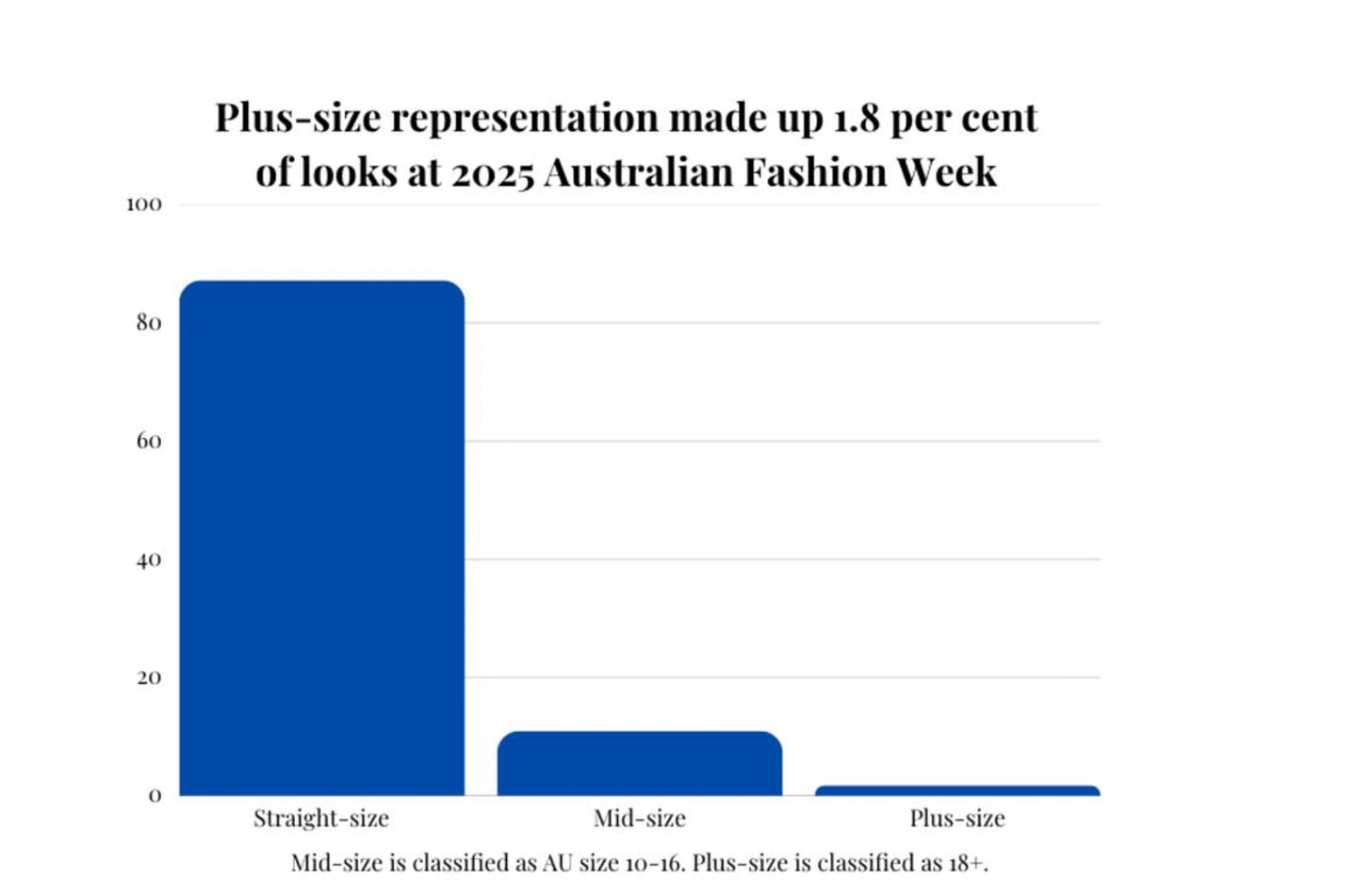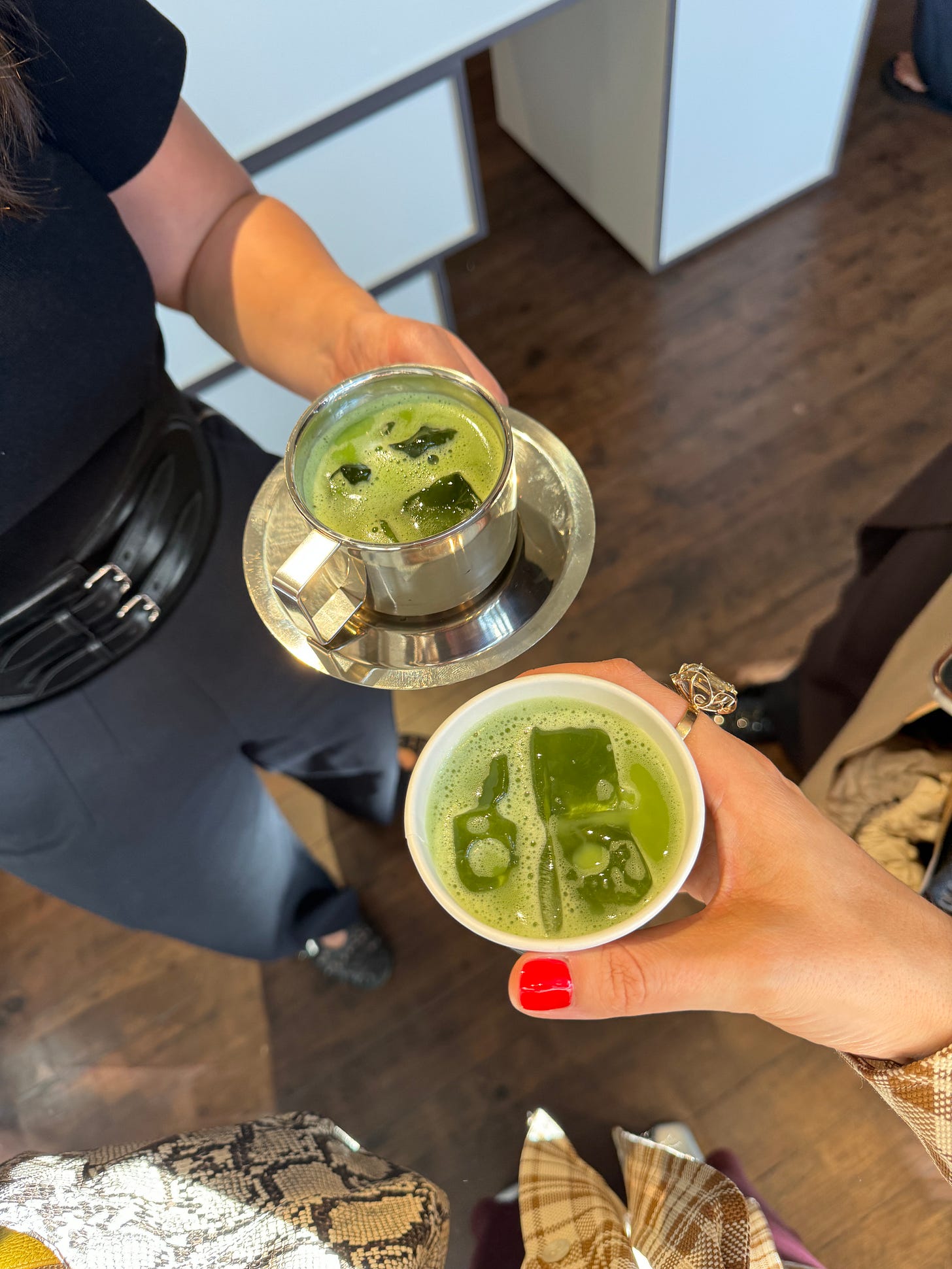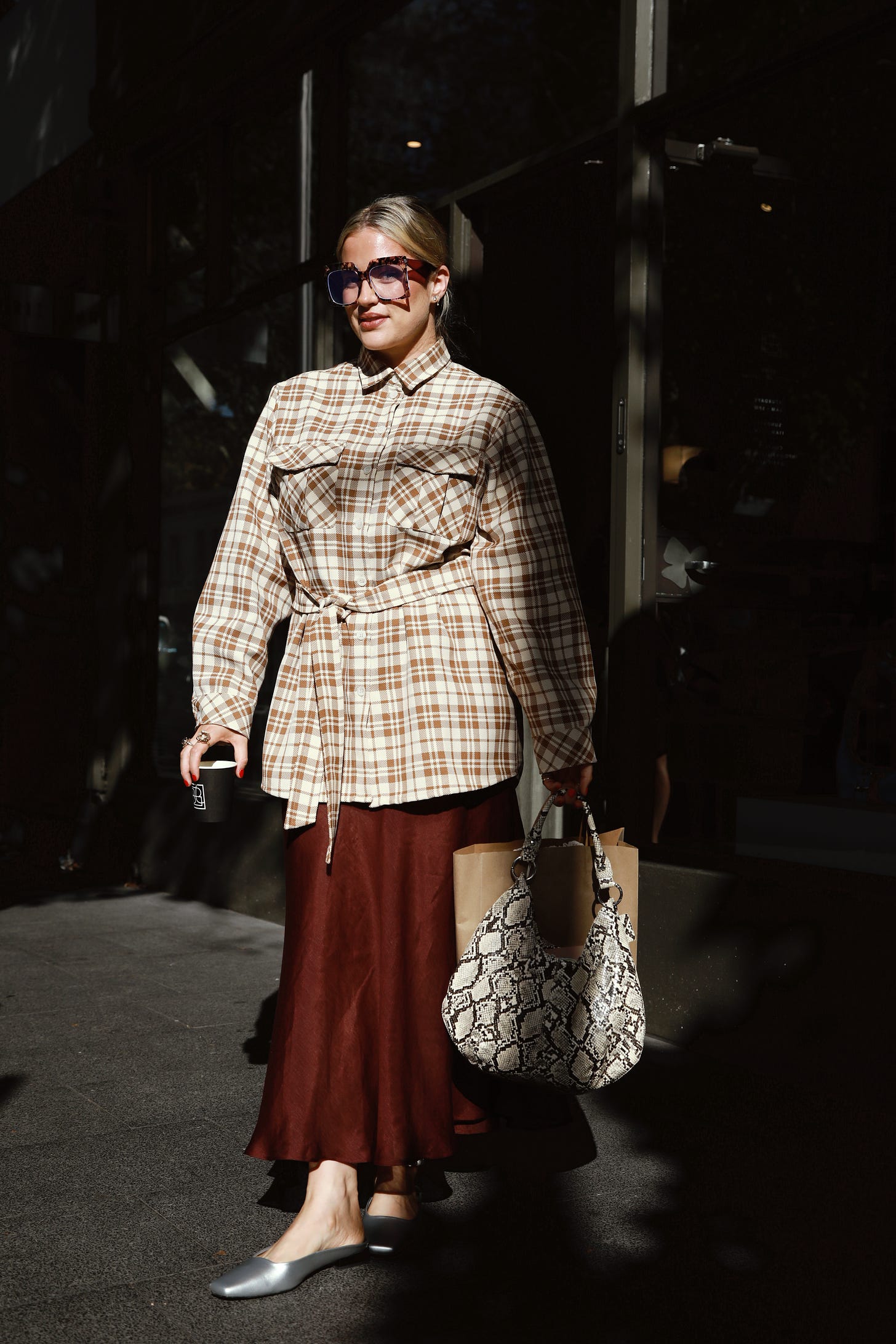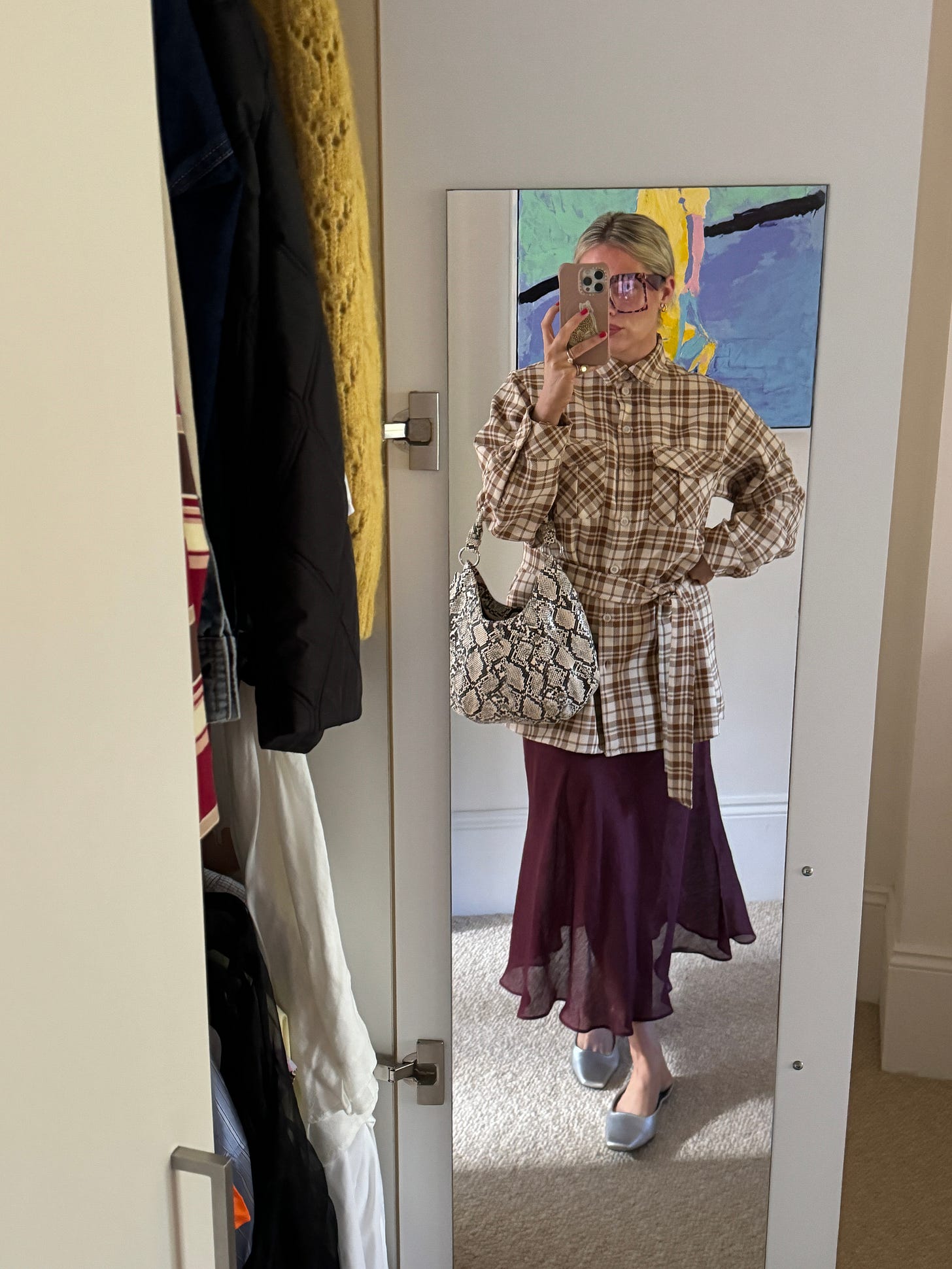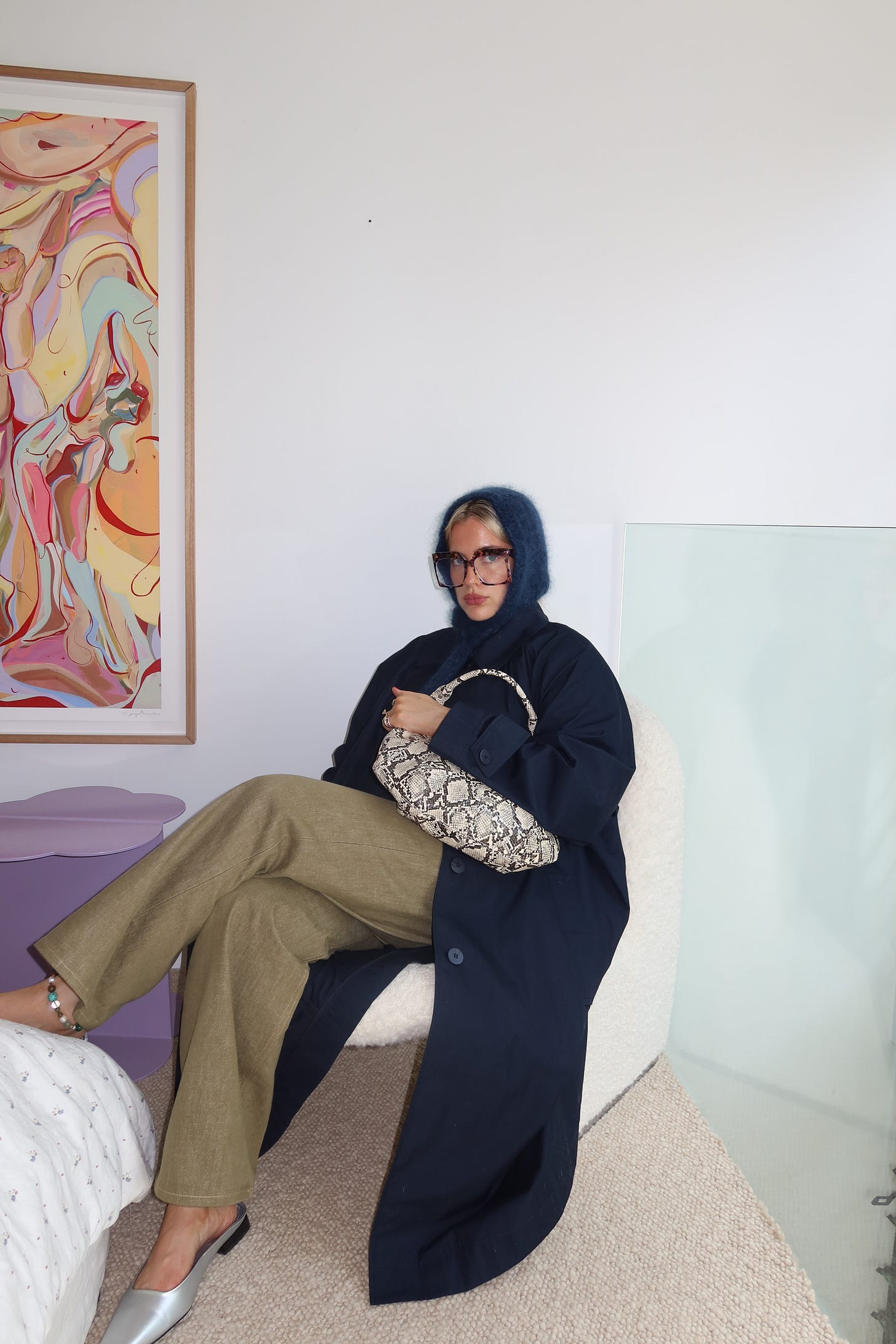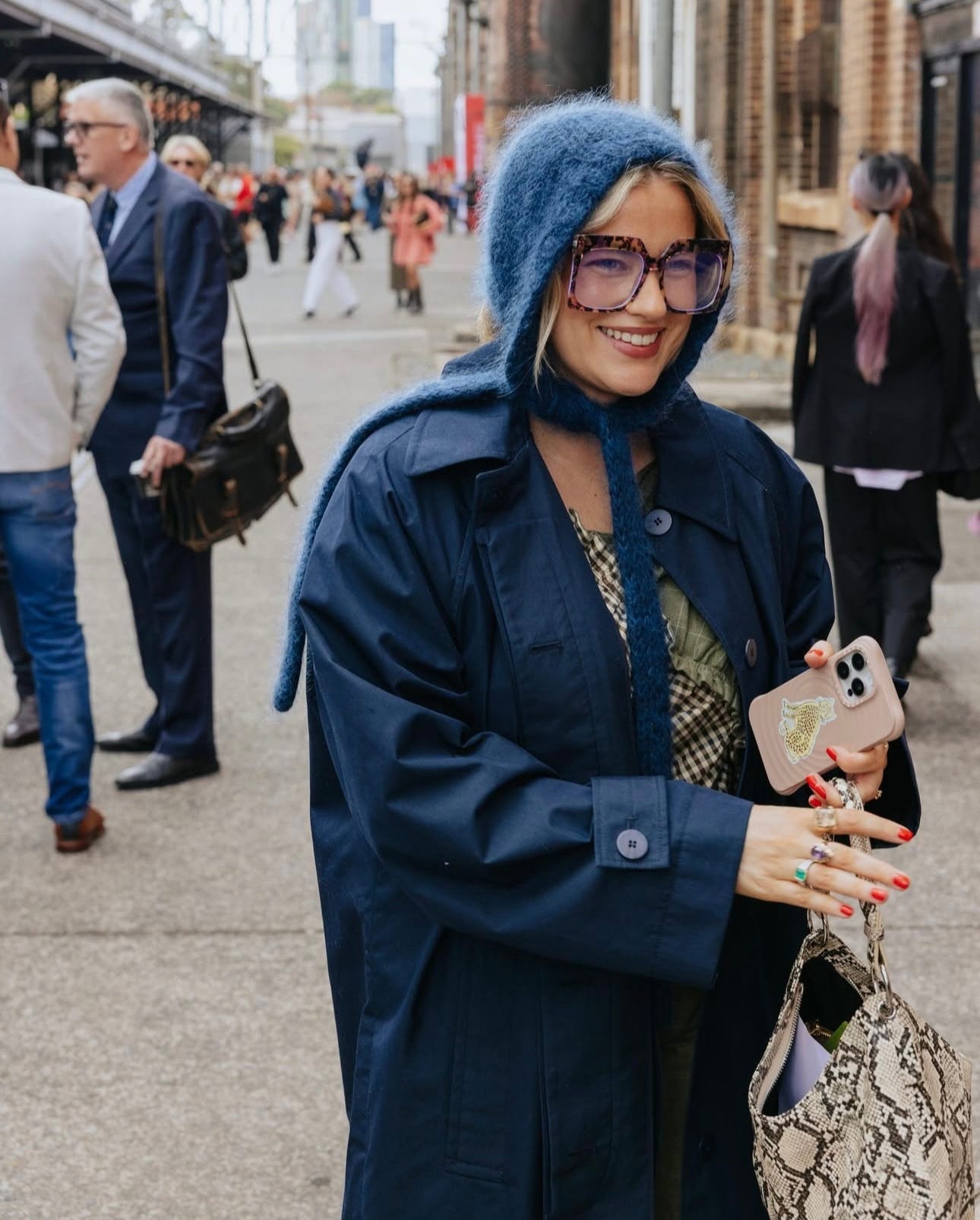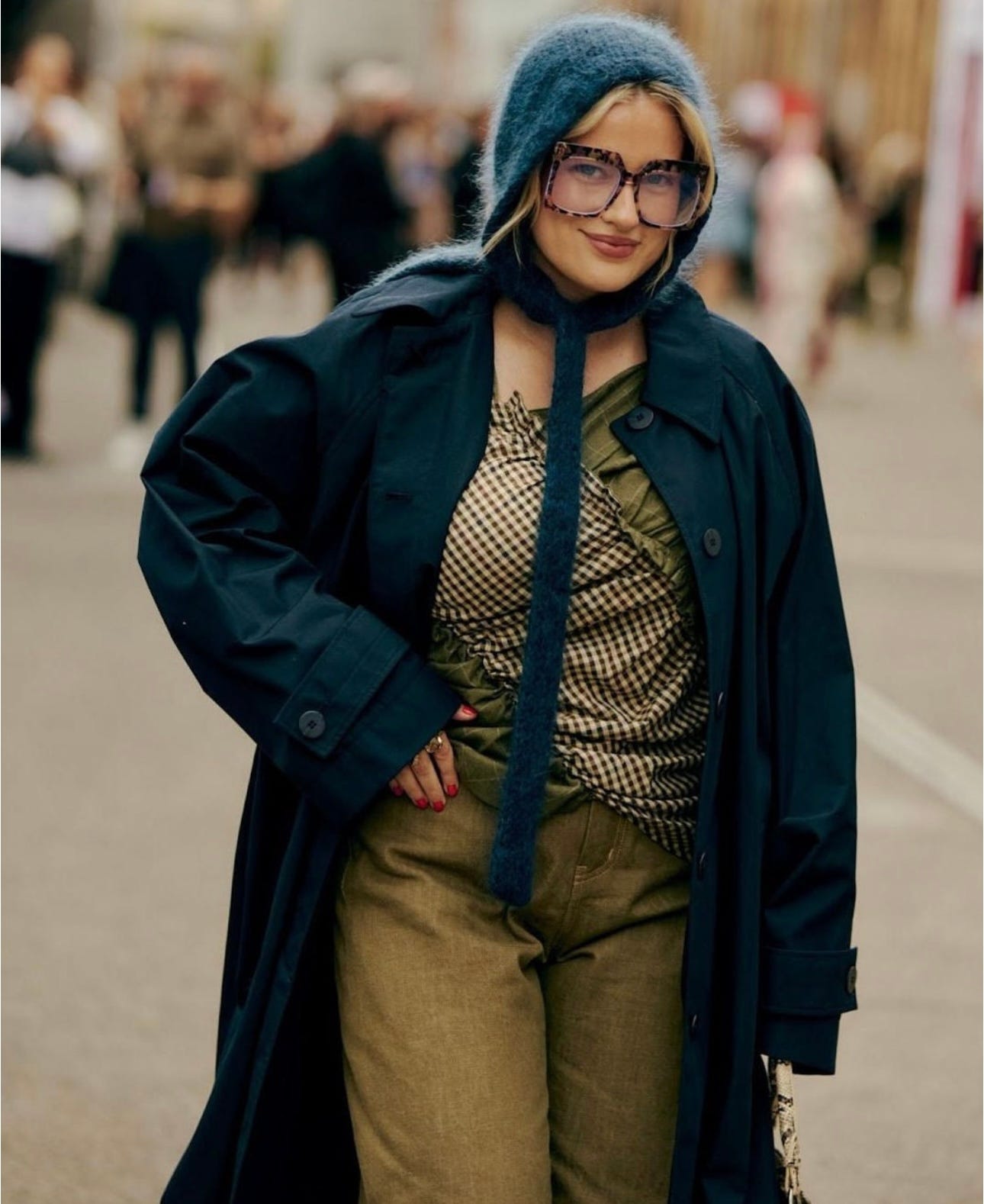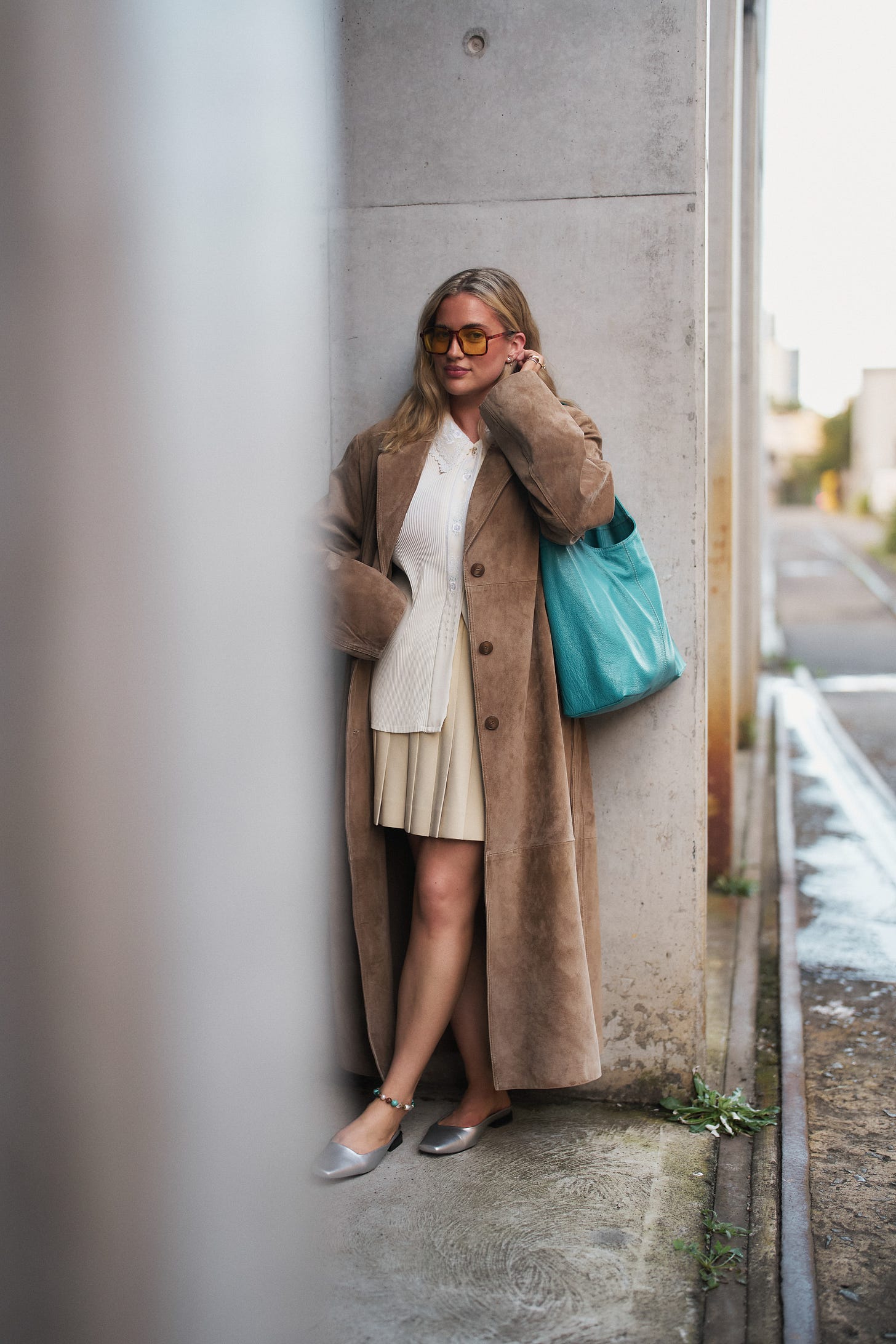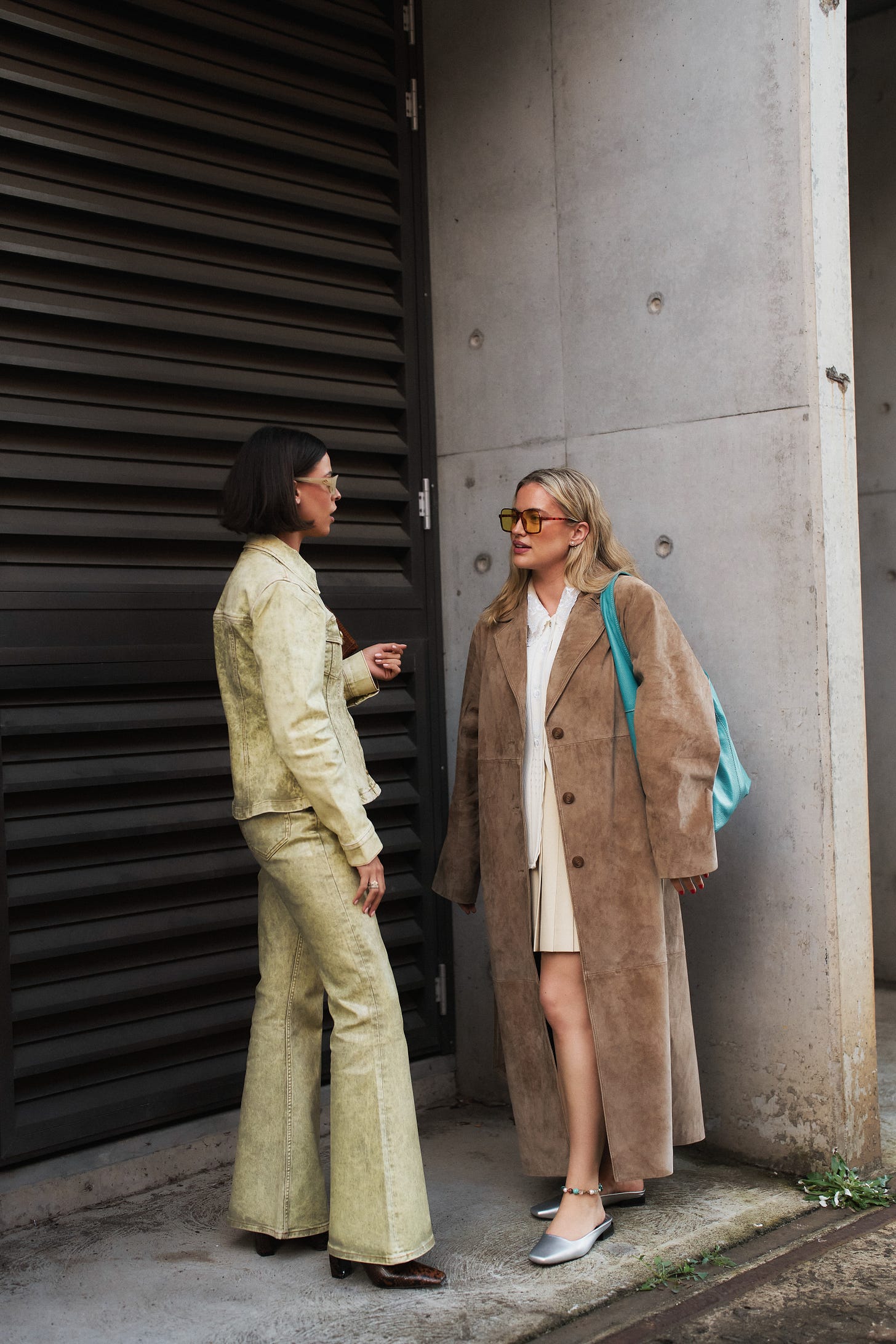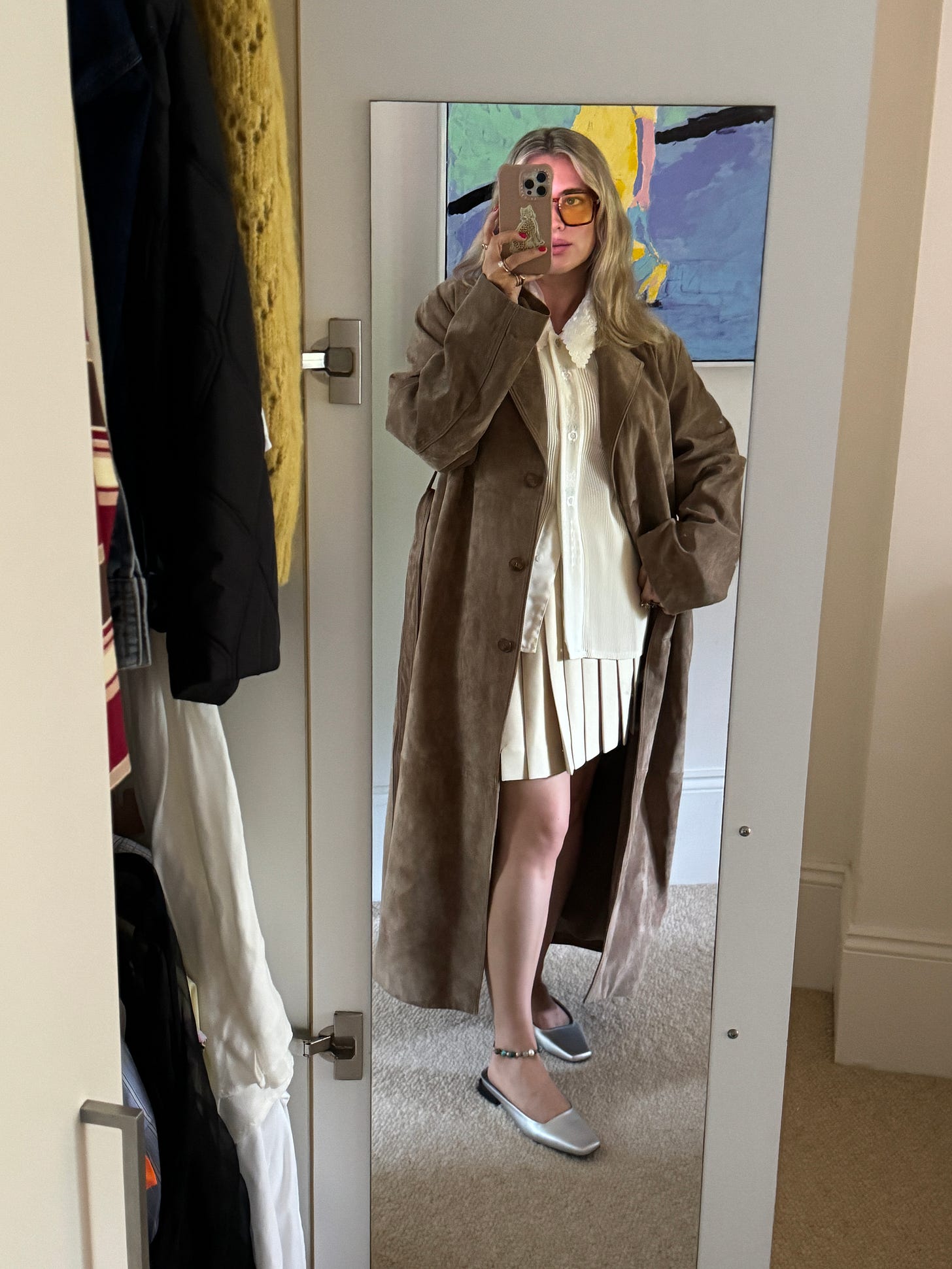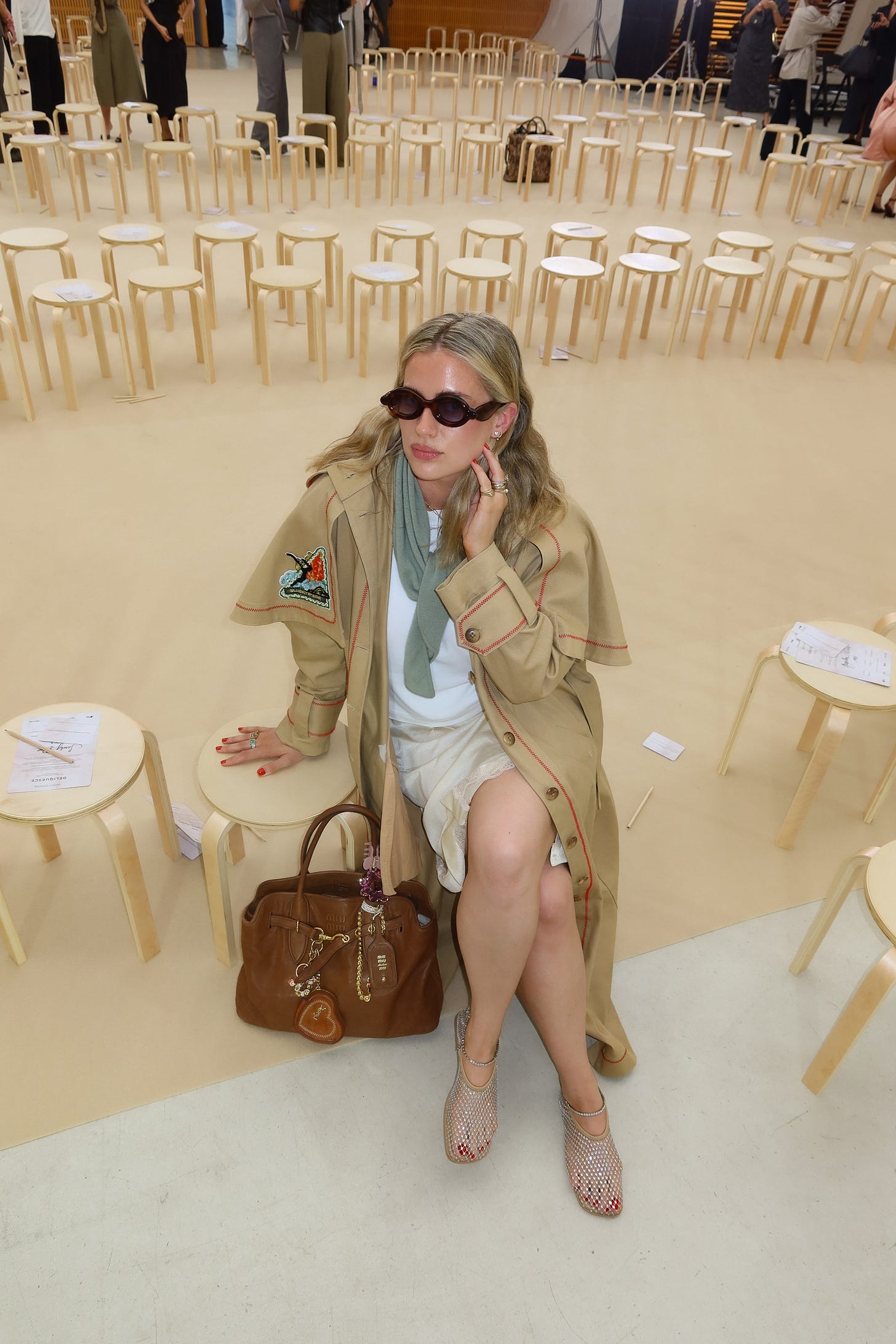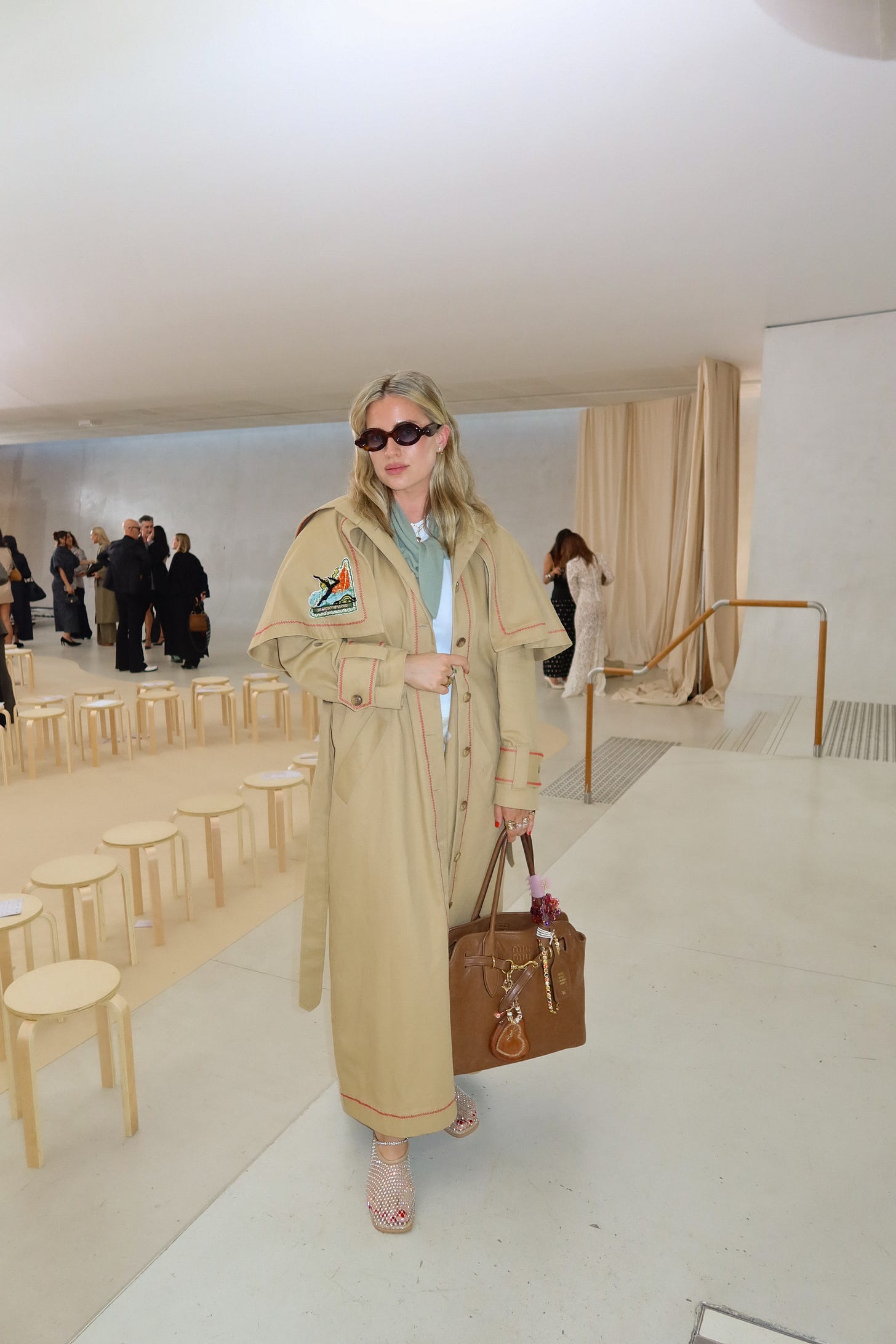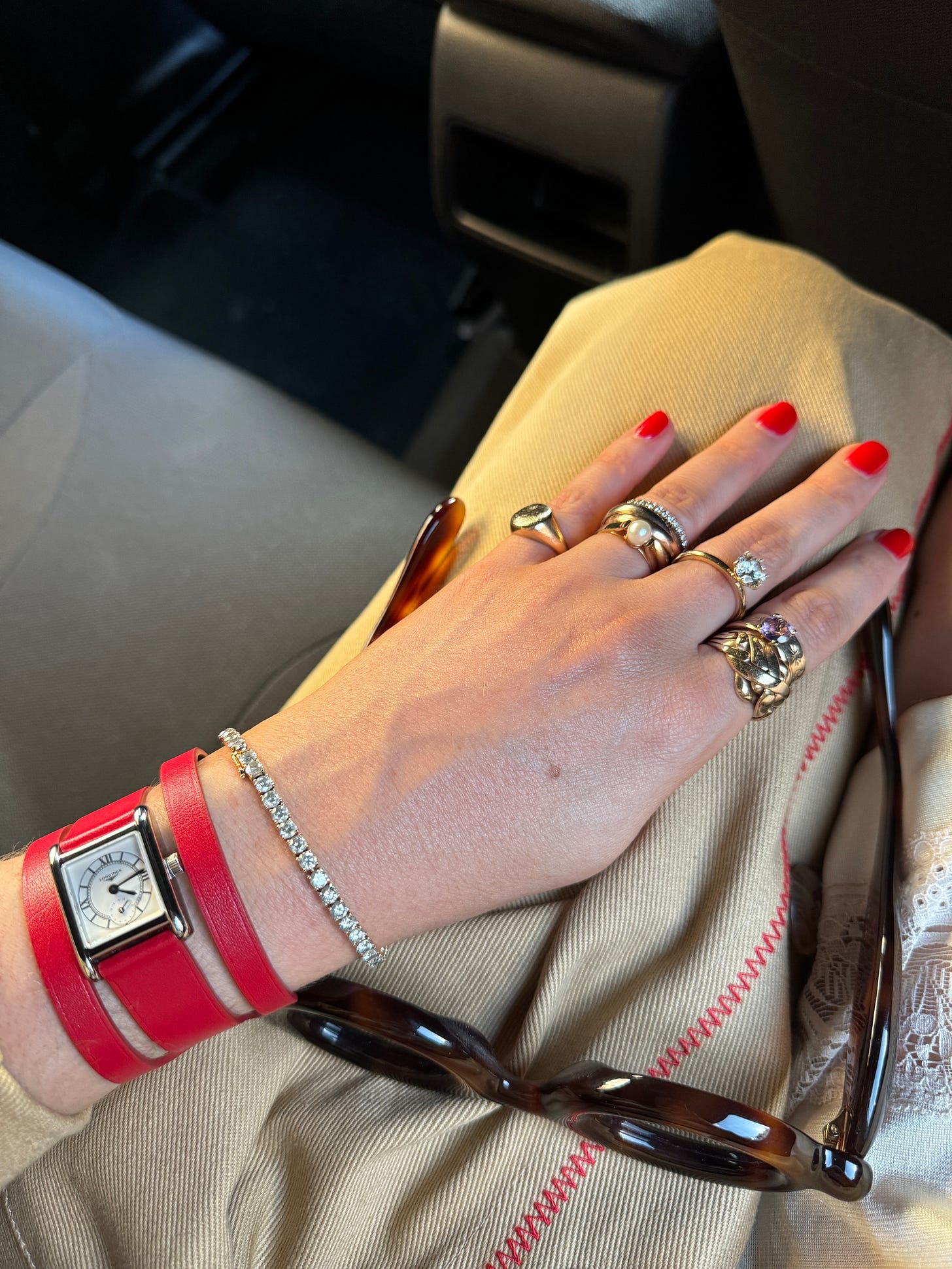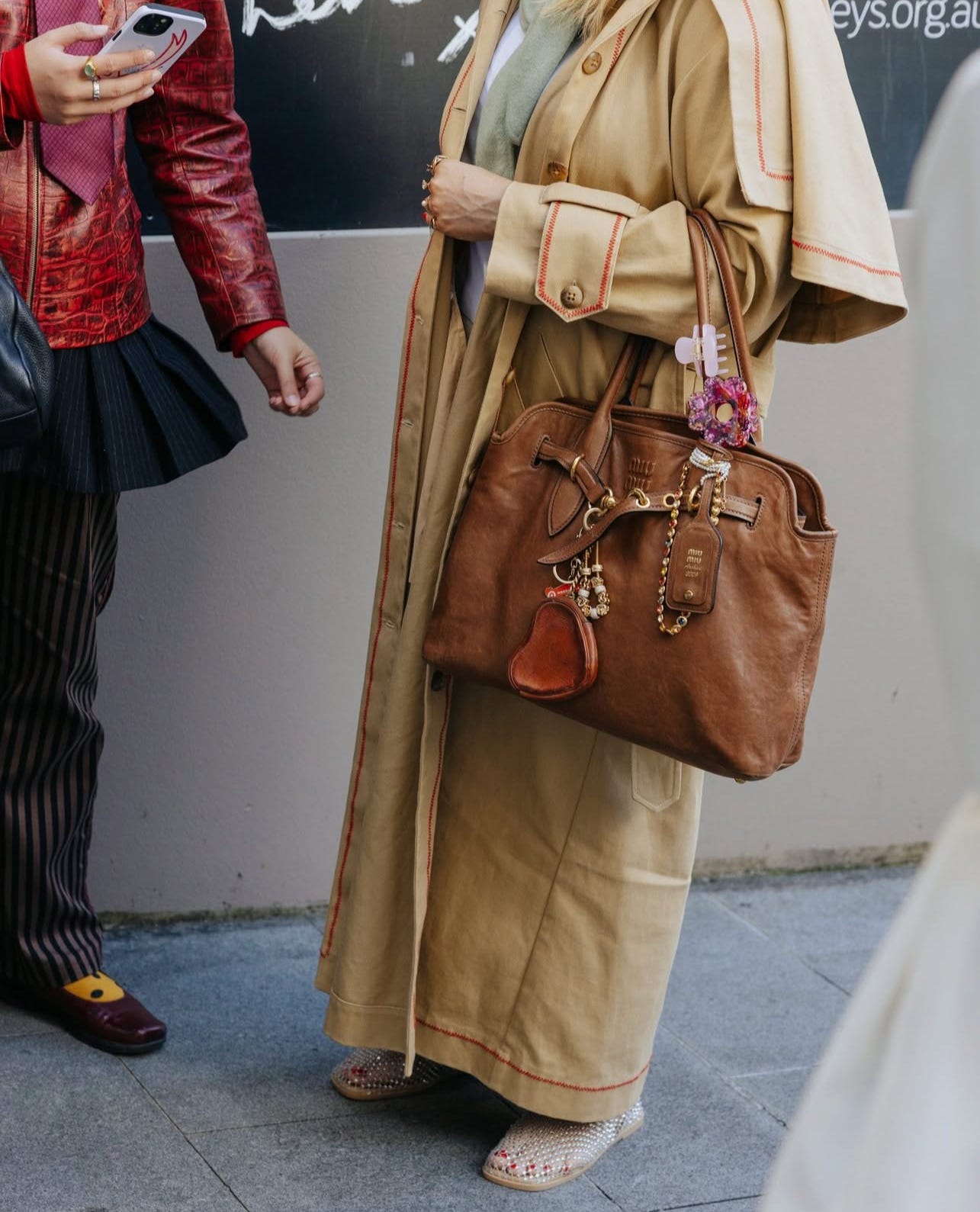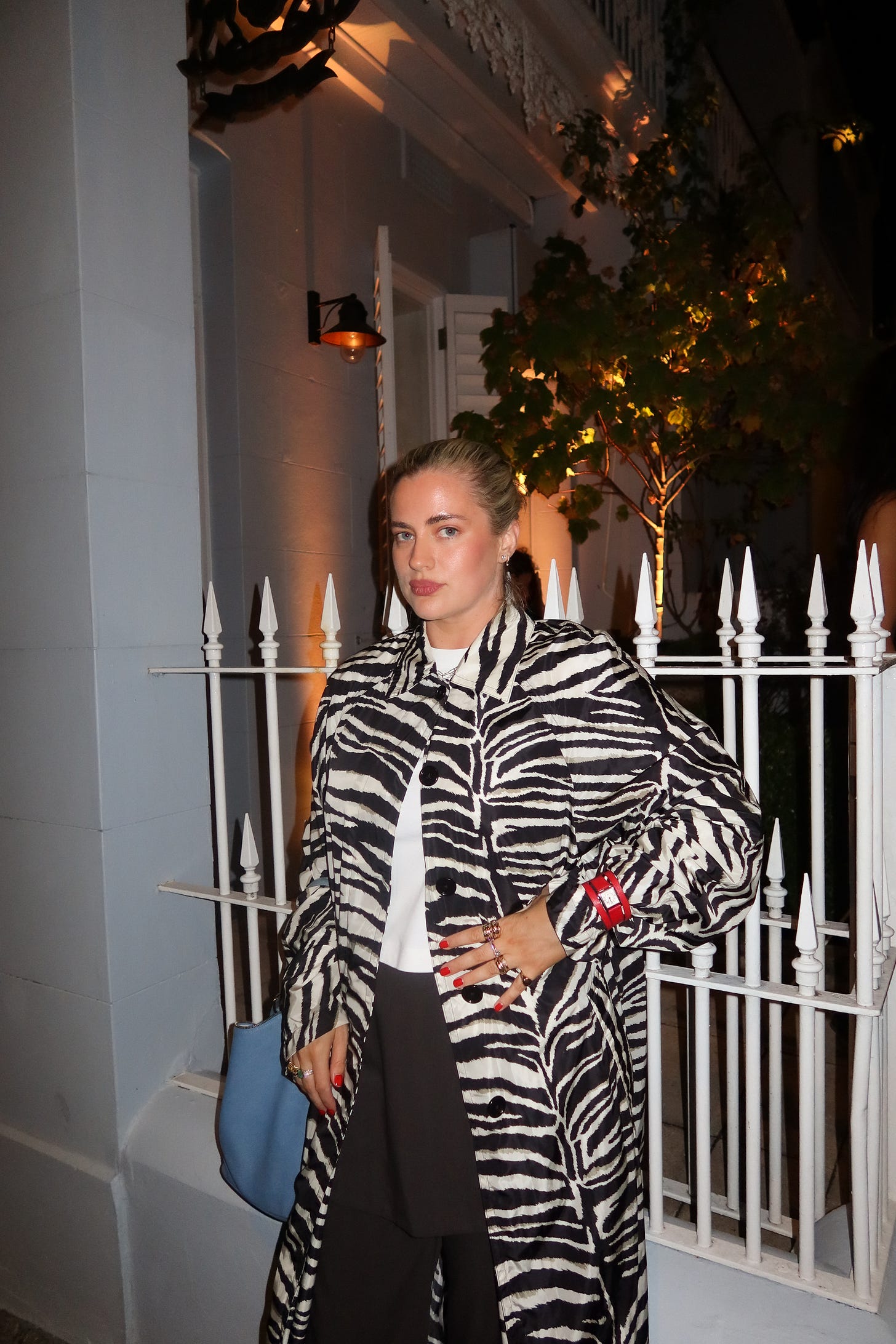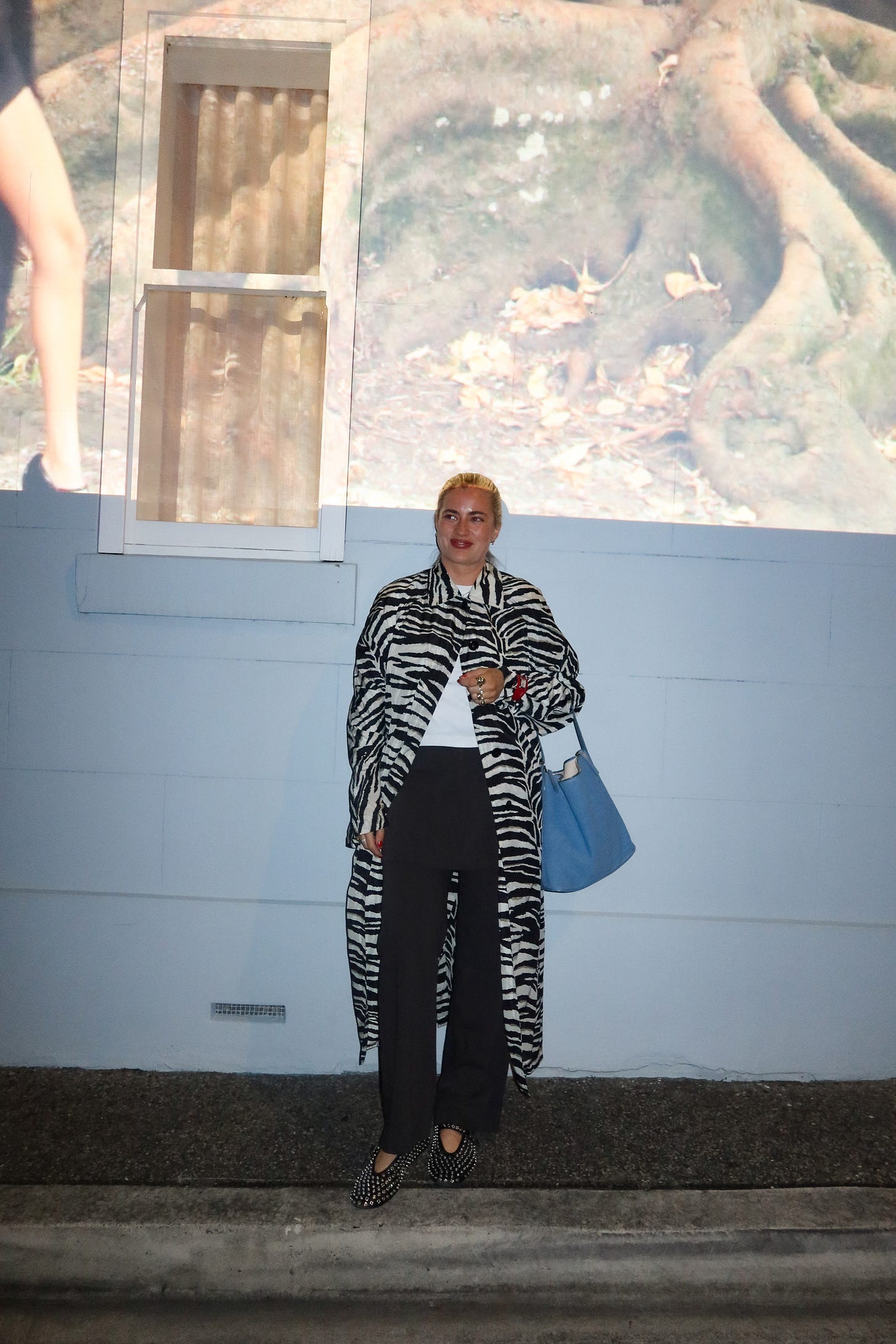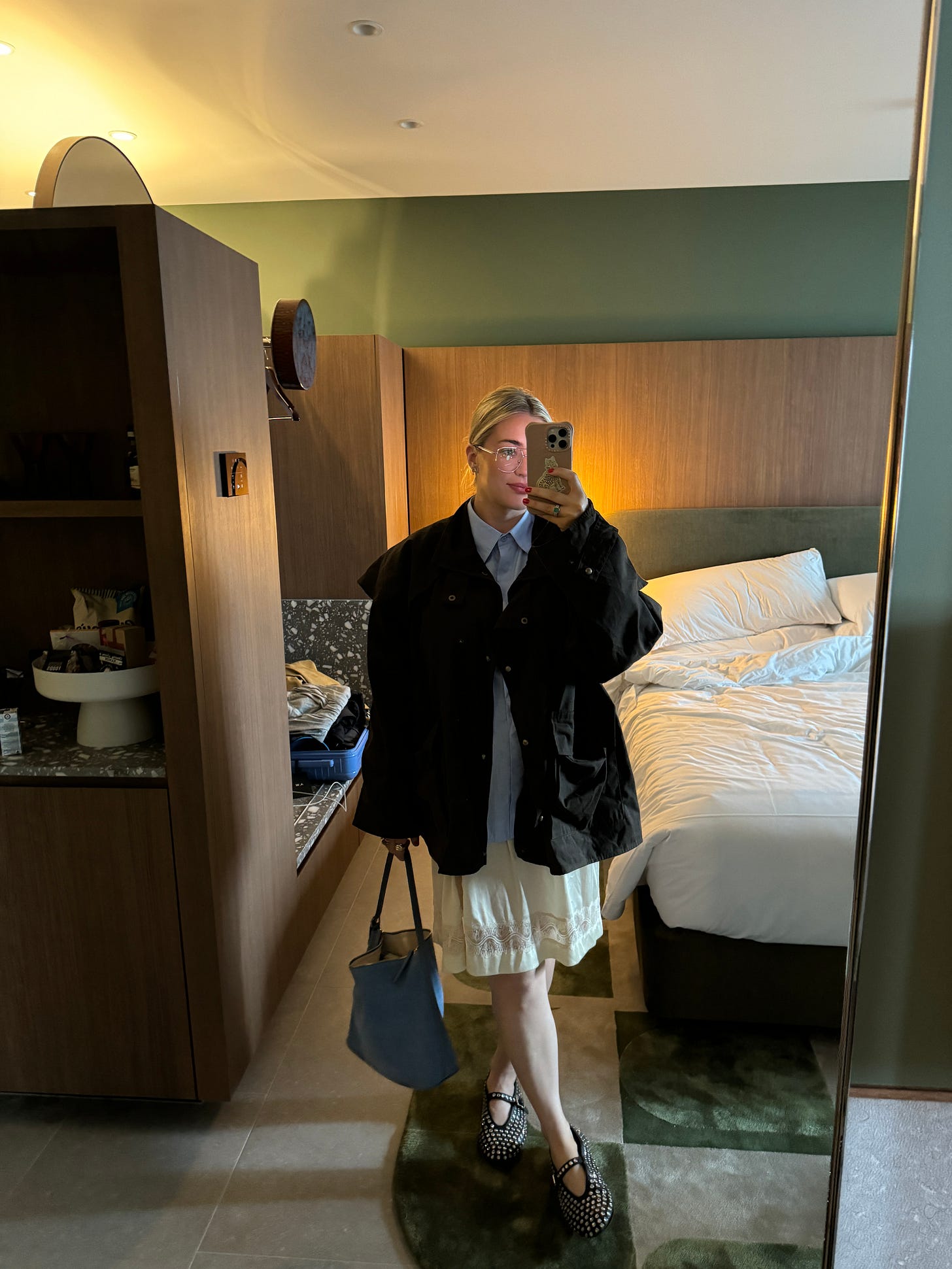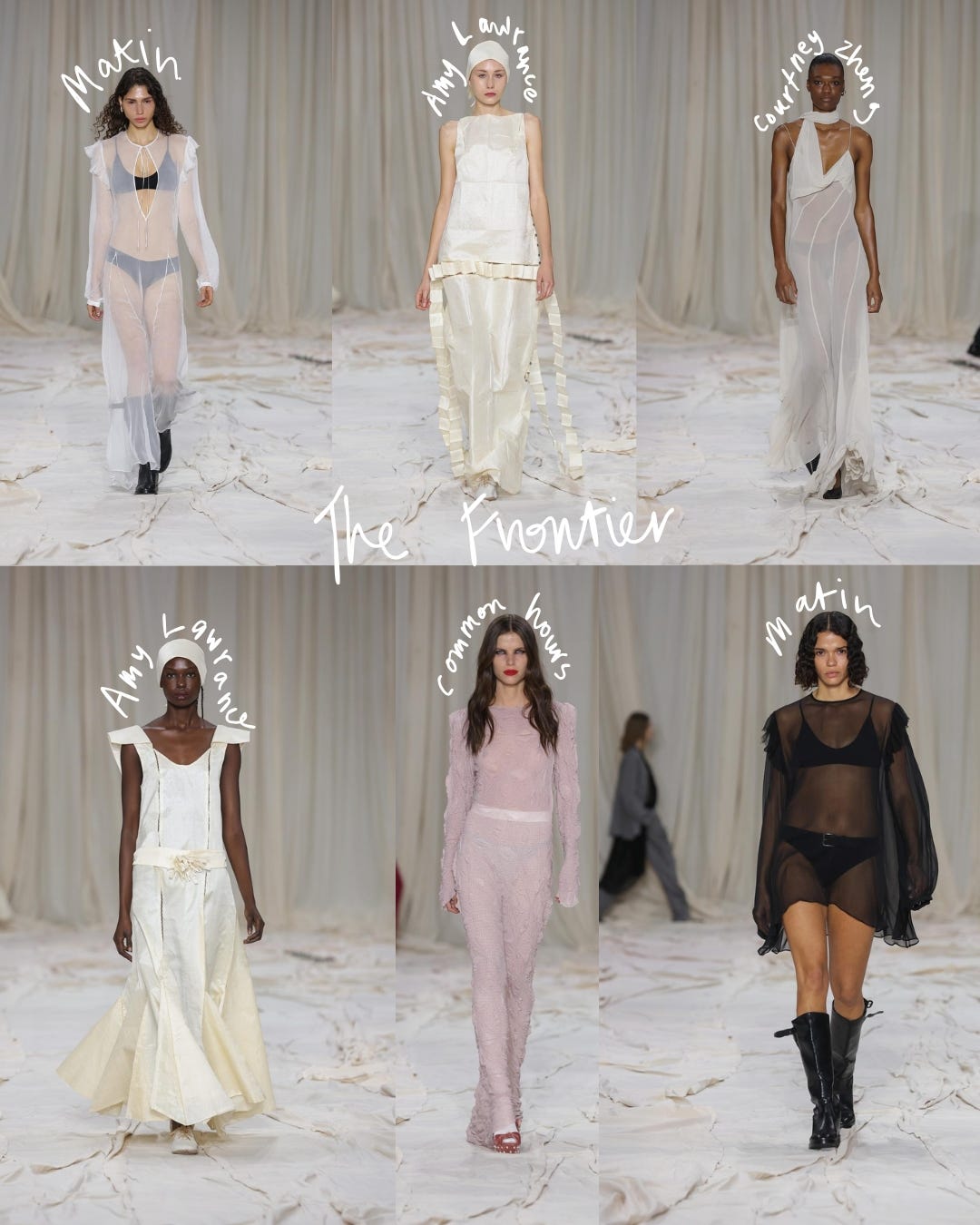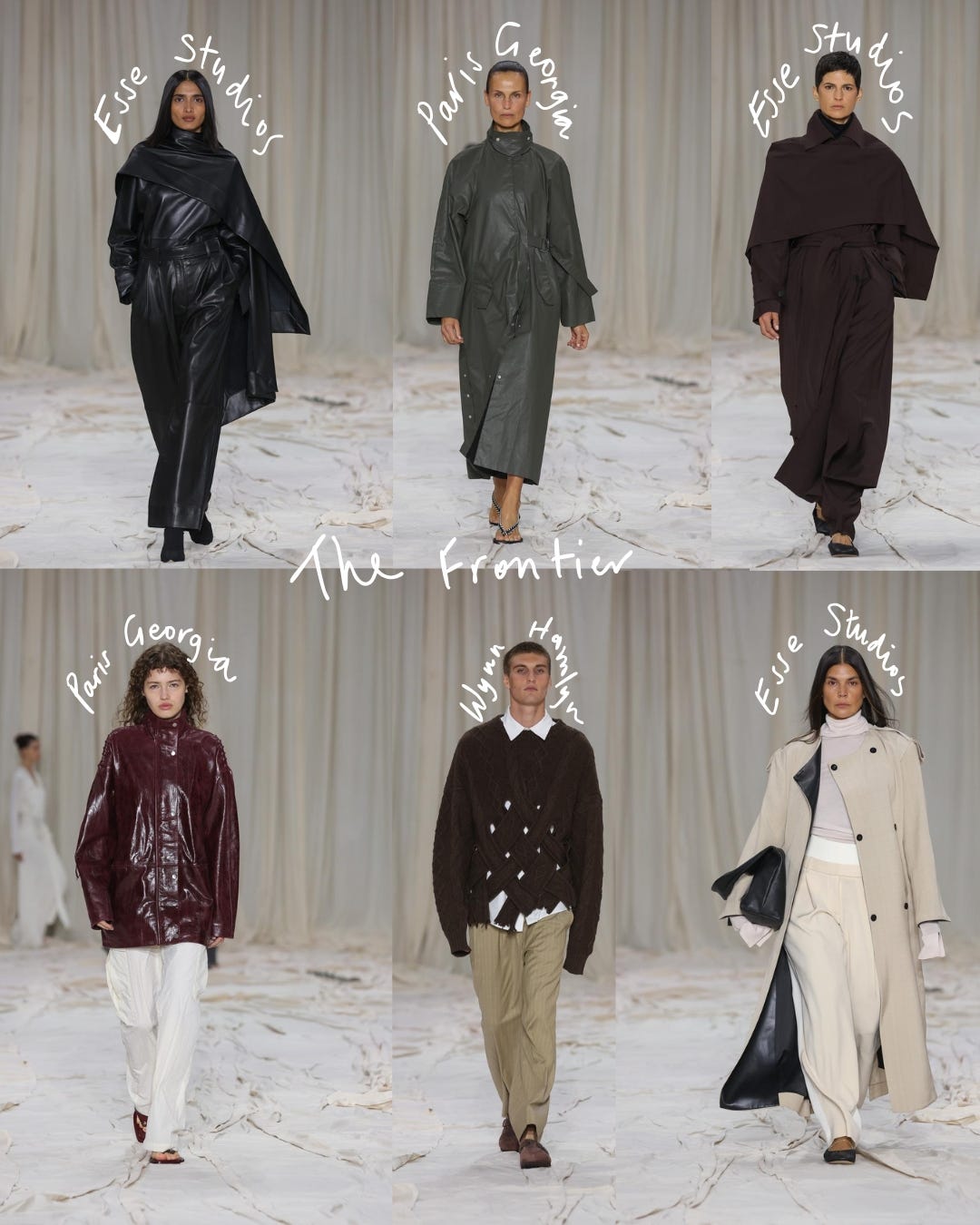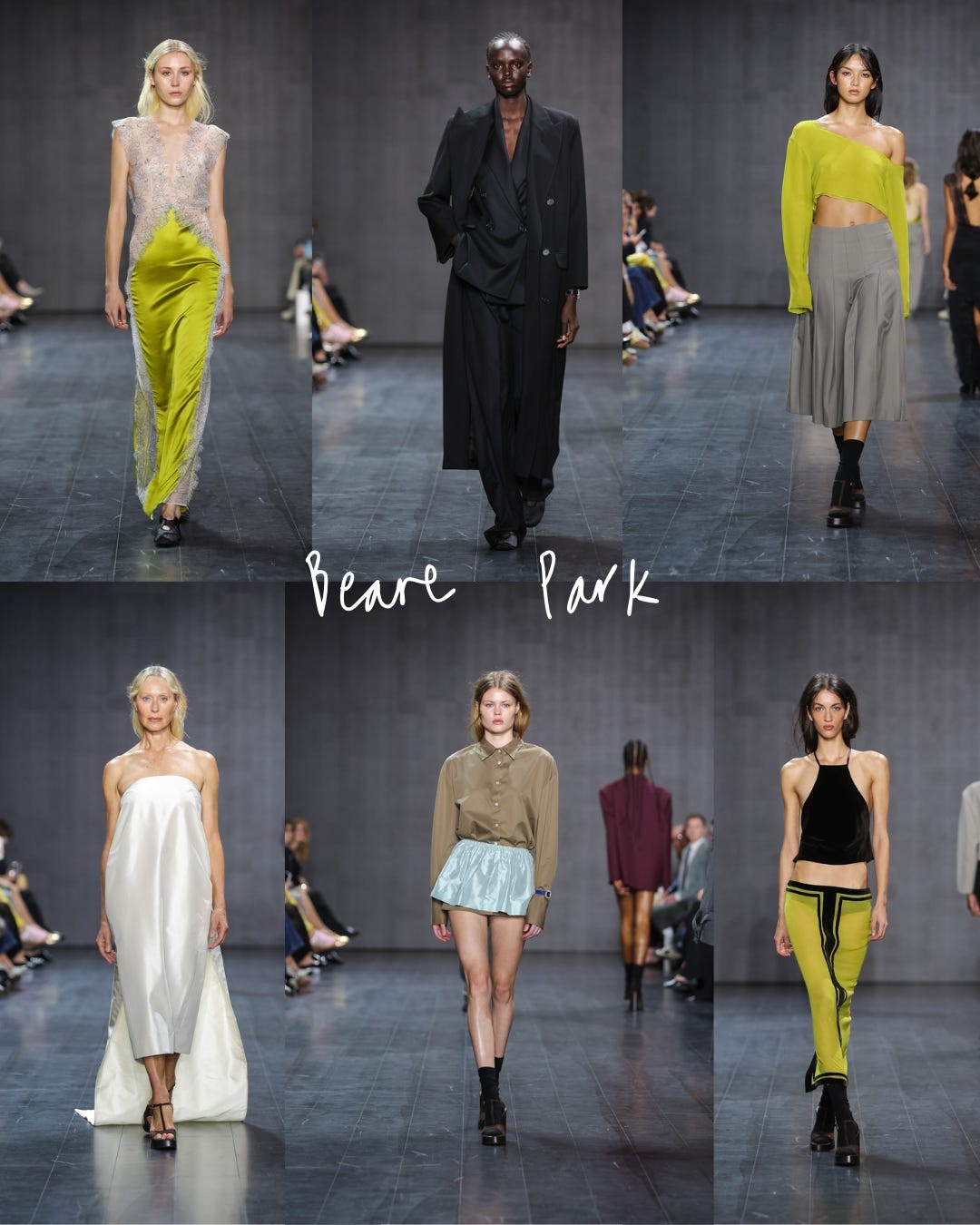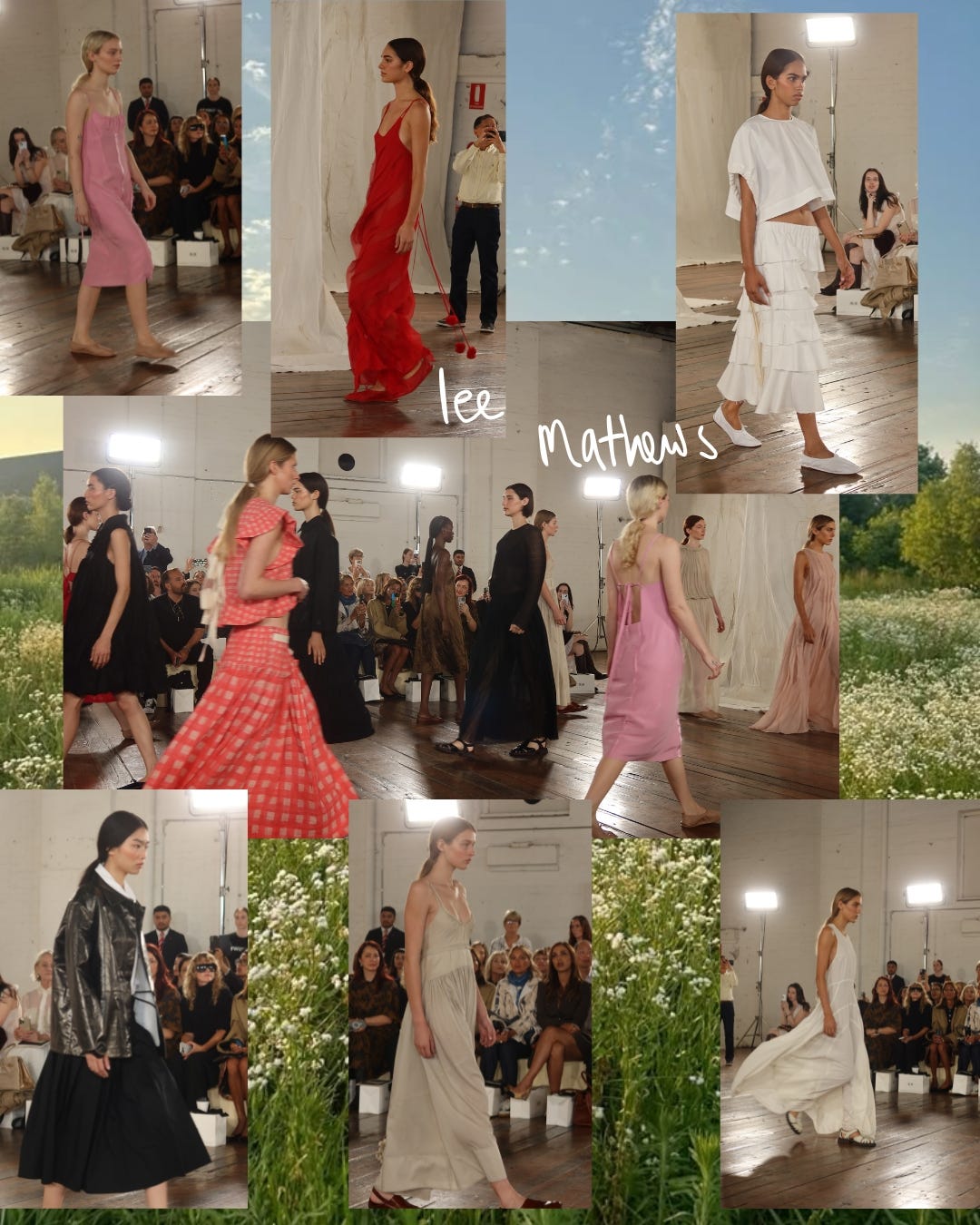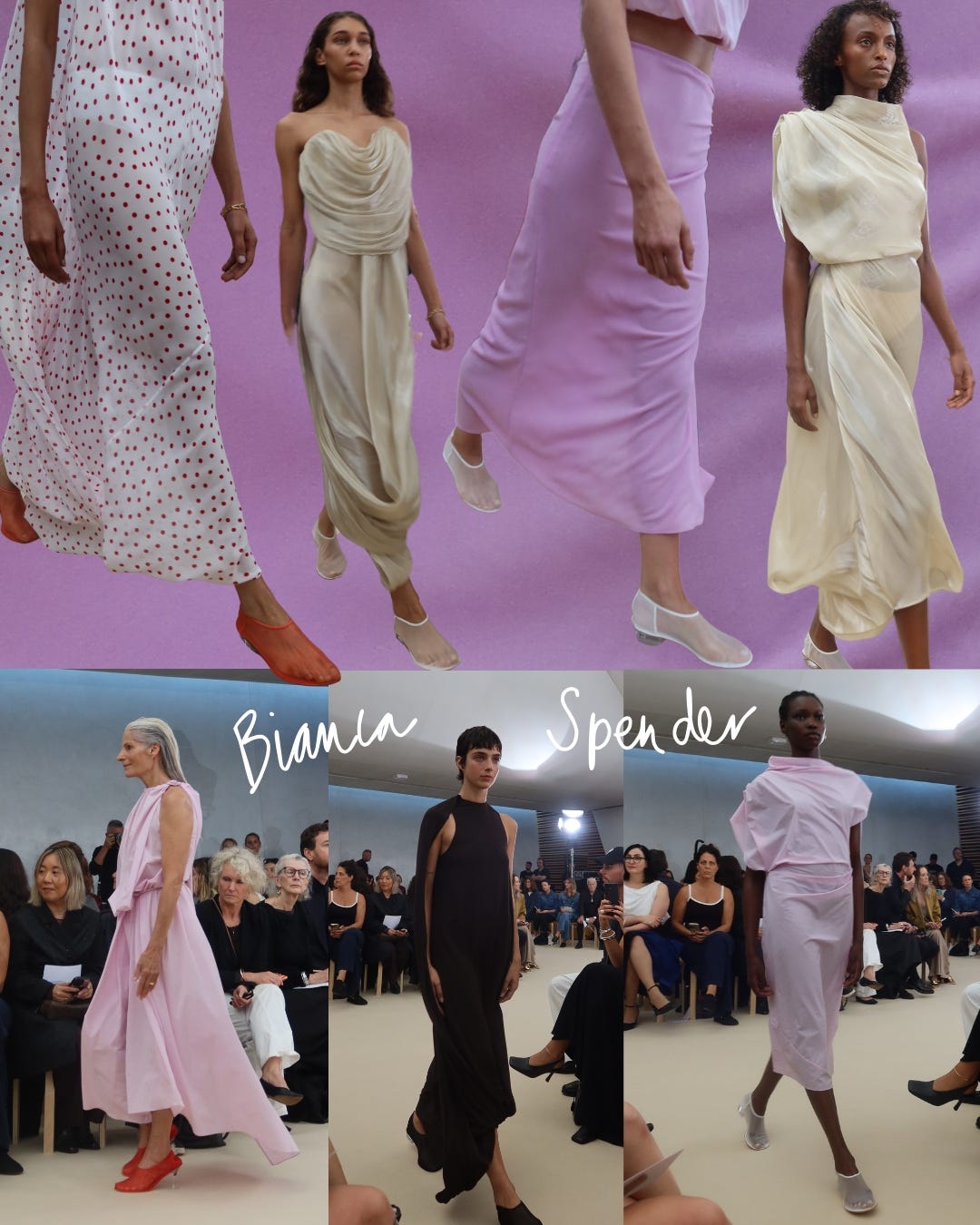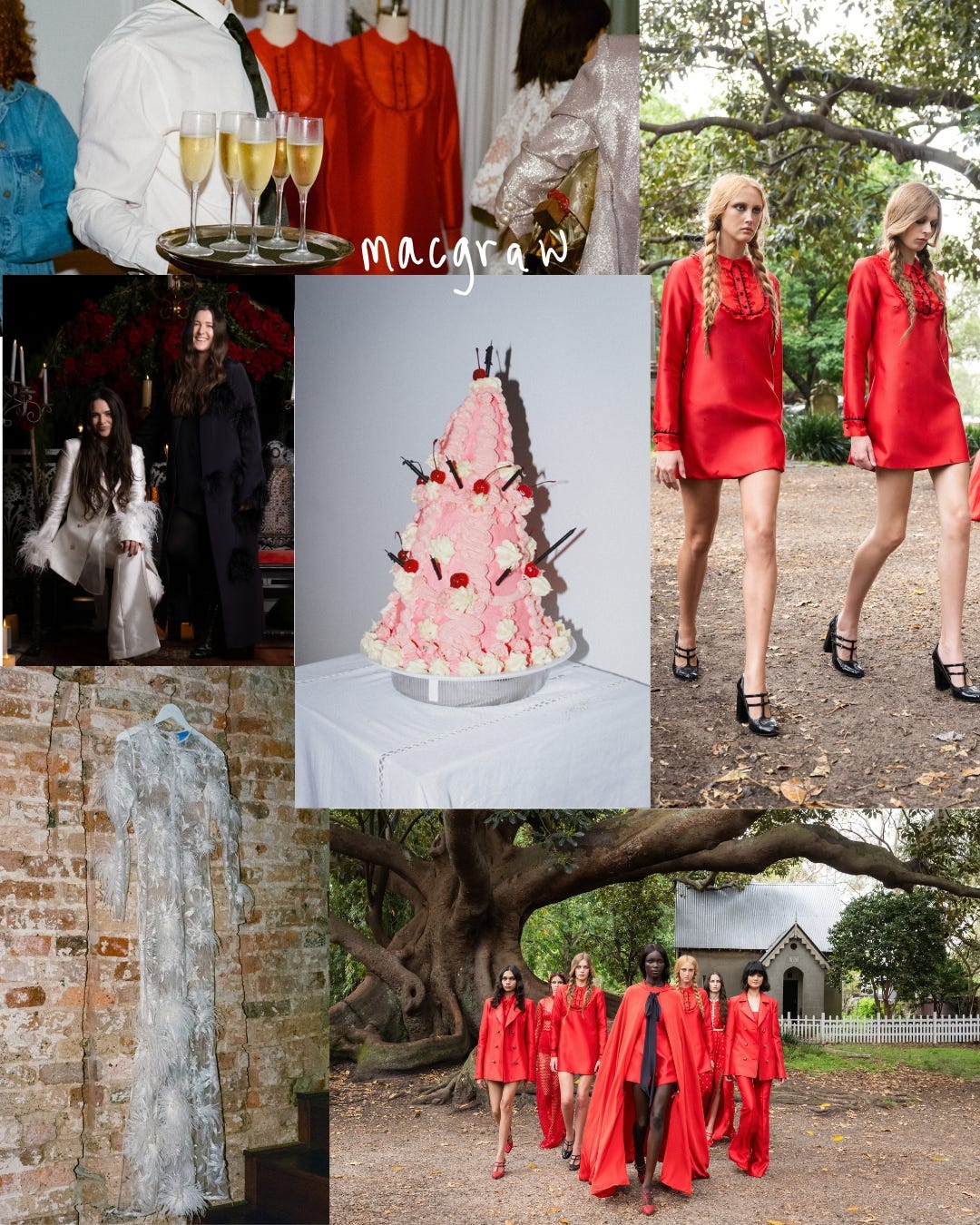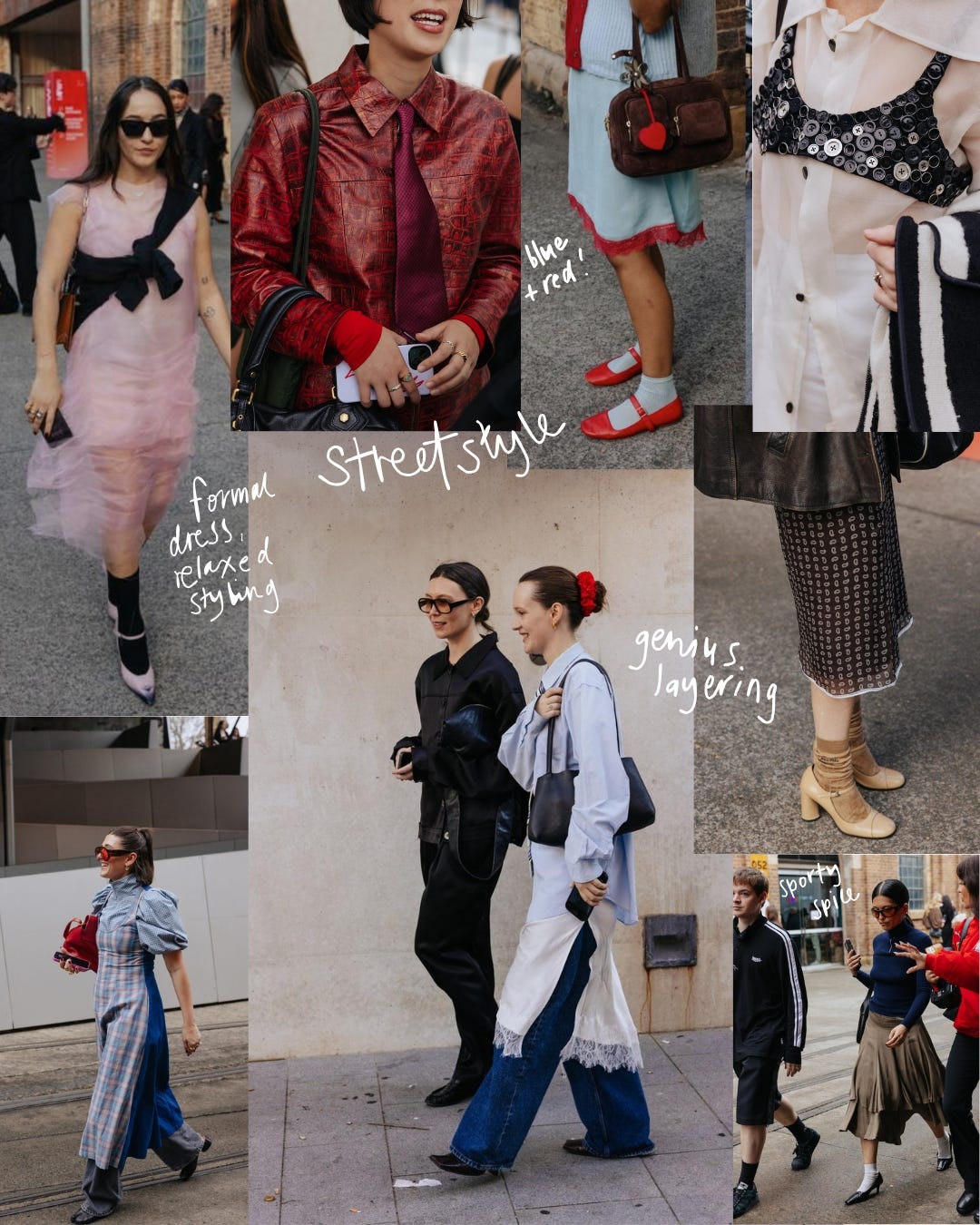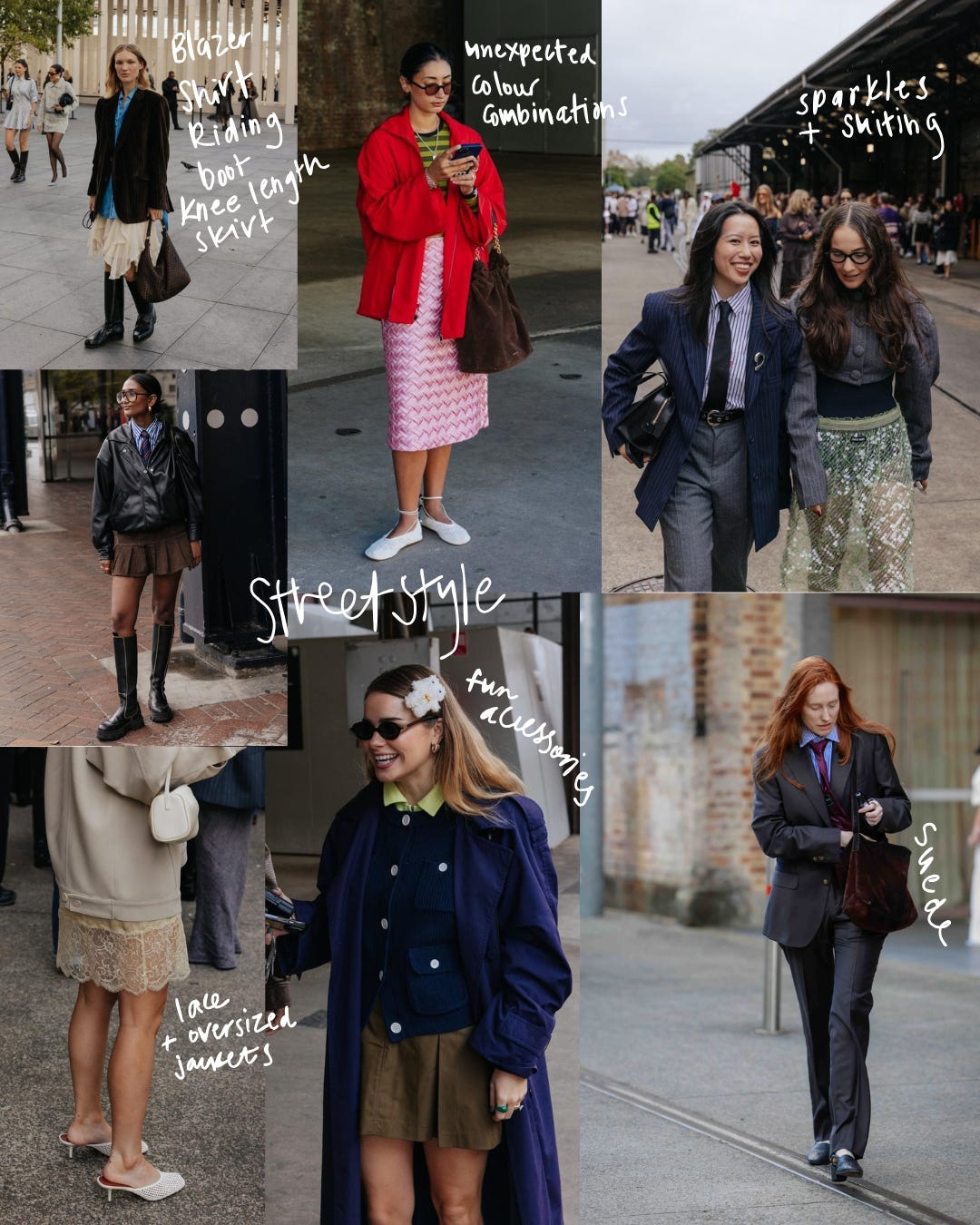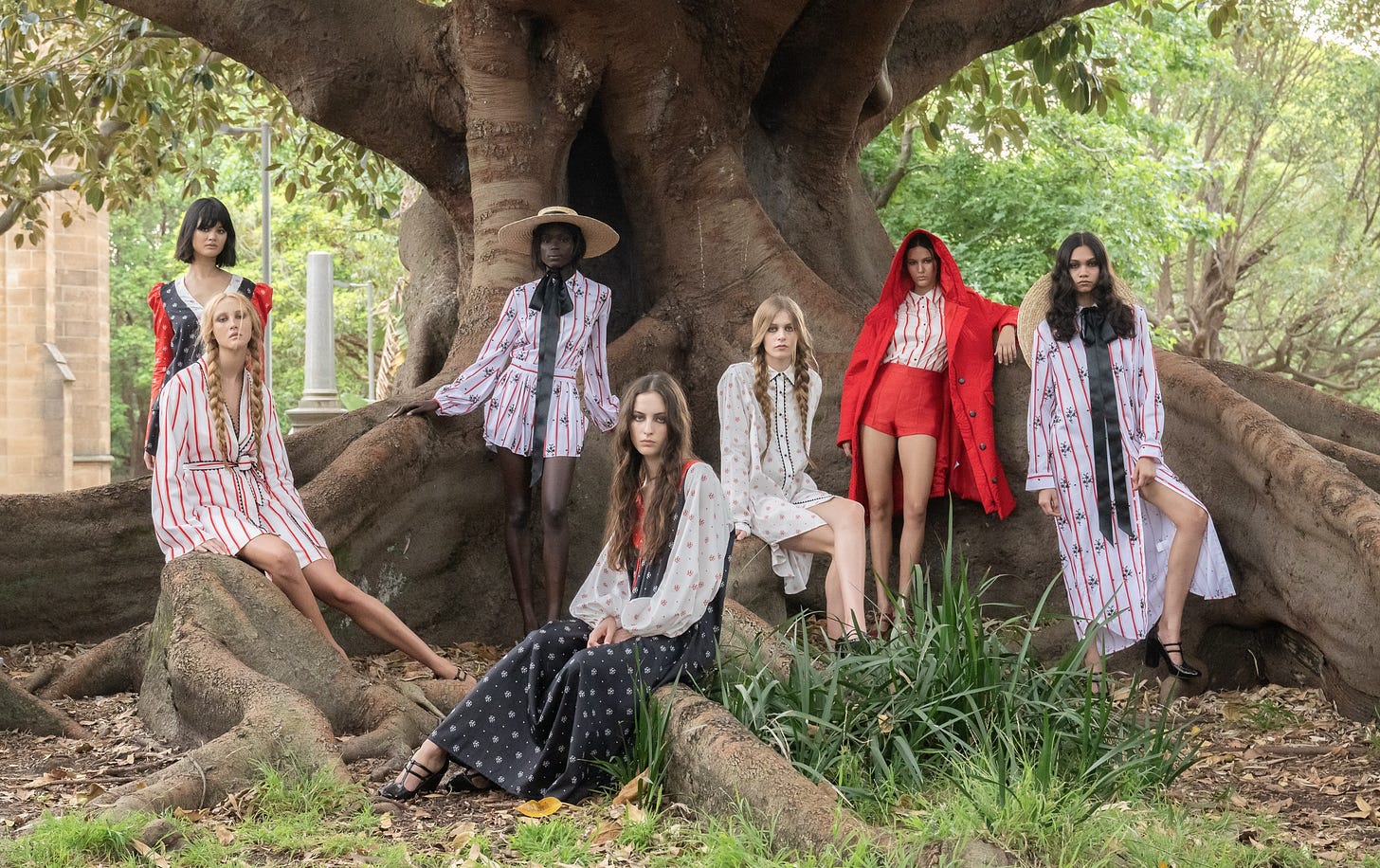Australian Fashion Week debrief
Everything I saw, wore and an interview with the designers of macgraw
It may only be 5 days, but Australian Fashion Week dominates almost all of May for me. Prepping outfits, appointments, organising the logistics, planning work for the week. Every year I attend, I learn more about how it works and how I like to do it.
It’s a week of great reflection of style - contemplating my own, what I see on the runway and of course, in streetstyle. I’m always left with a huge appreciation for those who create and make the week what it is. From the designers, hair and makeup artists, photographers, models, production crew, managers, agents and guests - this week is a mammoth effort and the work deserves celebration. It’s also a beautiful opportunity to meet new people, see old friends and foster deeper connections with my peers.
I was talking to friends about what the week feels like. We mused that not only is it the fashion olympics but it’s the social olympics too. How many shows can you race around to, how many events and meetings can you squeeze in and how little sleep can you function on? There’s a reason the weekend following fashion week I literally block out my diary saying, “NO PLANS.” I simply have to disappear afterwards. The social battery is left in the negatives.
Note: This substack is a little long - if you’re reading this via your email, it’ll say ‘View Entire Message’ at the bottom - click on that to keep reading, or view the entire newsletter in the Substack app (my preferred way of consuming these). PS All the fashion related content is at the end :)
Reflections on the week
If you’ve been on the internet during the last week, you’ll have seen social media has been flooded with hot takes about AFW. In this substack, I’m going to share my outfits and prep leading up to the week, my favourite looks and shows, streetstyle I loved and an interview with the designers Beth and Tess from macgraw.
I don’t really want to add to the other noise other than sharing these two points.
Firstly, the diversity factor. Diversity is of course lacking in the fashion scene. It’s not unique to Australia and it’s always been this way. I know that not every brand is able to cater to every person’s need but across the board, things do need to improve.
Never more evident is the need for change than in Australian Vogue’s Size Inclusivity report (it’s so helpful that they do this!). The Vogue team analyse every runway show from the official AFW schedule to calculate the proportion of total looks that are straight-size, mid-size and plus-size.
Here’s the breakdown, directly from the article: “Of the 716 looks presented as a part of the 20-show official schedule for resort 2026, made up of in-person solo or collective runways, 1.8 per cent were plus-size (AU 18+), 11 per cent were mid-size (AU 10-16) and 87.2 per cent were straight-size (AU 4-8). Last year, of the 1,209 looks presented by 38 separate designers for the resort season in 2024, 1.1 per cent were plus-size, 8.7 per cent were mid-size and 90.2 per cent were straight-size,” Vogue reports.
Designers Gary Bigeni, Nicol & Ford and Iordanes Spyridon Gogo were the most inclusive shows throughout the week.
I’d personally love to see more representation in size, age and race at Australian Fashion Week. I’d love to see that reflected across the runways, campaigns, brand identities and of course in the product range they sell. It would be fantastic for more brands to expand their size range so more people can have access and can feel included. When you don’t see yourself represented consistently, it makes you feel like you’re the problem and you need to change.
Secondly, Australian Fashion Week has yet again unfairly copped so much criticism. There’s always room for improvement - but given the circumstances of this year’s iteration - I believe they did the best job they could do to make it all happen. Switching from IMG managing the week - a for profit endeavour - to the Australian Fashion Council (not for profit) stepping in 6 months out, with government assistance, to make the week happen. Because of this the schedule was leaner, the week a bit smaller.
All of the negativity surrounding the week made me so sad when it’s a privilege to have an Australian Fashion Week at all. It nearly didn’t happen this year and that would have been devastating. I think of all the designers and their teams that have poured their heart and soul into putting on a show, the money and energy spent to make the week happen - and then to see the unfair discourse unfold, with little discussion around the actual designs - if I was them, I would be seeing red. There was so much beauty and magic to be celebrated, brands that design and make their pieces in Australia, building their businesses when they’re up against immense difficulties (eg tariffs!!!).
Then there was the savage and frankly incorrect blanket statements over what guests wore. Fashion is meant to be fun, playful and based in self-expression - Australians have incredible style and the streetstyle was amazing.
OK, Moving ON!!
Prep:
Some years I’m more organised than others - this was an organised year.
I got my hair cut and coloured at Headcase Hair in Paddington a week prior to AFW.
Mani + Pedi at Polished in Paddington - a few days before AFW.
I’ve been slowly and quietly shopping for some pieces in the last few months
Showroom visits + discussions with brands about loaning/gifting (more on this below) - this starts to happen roughly 2 weeks out from AFW.
Once I have all my clothing / accessory options I pull everything together in my office and start working out outfit options. This really helps me see what we’re working with and all the possible combinations. I do this generally the weekend before AFW.
Infrared Saunas at Nimbus. This helps me unwind. I just feel so much better after a sauna!









How I figure out what to wear:
The weeks leading up to fashion week include meetings and appointments at PR agencies that represent brands that may be showing or those that have clothes available to loan. The major issue I’ve come up against with this is the lack of size variety as these showrooms generally have only size 8s, maybe 10s if you’re lucky. I generally don’t fit into these sizes. What I prefer to do is reach out to brands I have strong relationships with and borrow from them directly. This ensures I get the sizes I’ll be most comfortable and myself in.
Brands I always reach out to - Maggie Marilyn, Lee Mathews, Alemais, Ganni, Friends with Frank. My own wardrobe is full of these brands. I love what they make and the people behind the brands.
The other main priority for me is to wear my own clothes. Not a revolutionary move but the pull to stand out during Fashion Week can be overwhelming - and in the process of falling into this trap you can lose yourself a bit. I’ve learnt the best move for me is to feel like myself and stay true to my own personal style. The ‘Fashion Week me’ is a bit more thought out and perhaps, elevated vs the everyday me. But that’s the point. Both are still me!
Every year things evolve. Attending Copenhagen Fashion Week has helped me work this all out too. The Scandi girls perfectly marry their own personal style, while supporting designers. It all just feels so effortless, fun and fresh. That’s what I’m aiming for.
Here’s everything I wore - I will detail which pieces are loaned.
Day 1 - Shows/Events - Hikuu x Brie Leon The Frontier, Lee Mathews, Nagnata
Look 1 - Maggie Marilyn skirt and jacket (both loaned), Brie Leon bag and shoes, vintage glasses.
Look 2: Lee Mathews jacket, top and pants (All loaned), vintage glasses, Mia Rachel bonnet, Brie Leon bag and shoes (I had to get changed in the Carriageworks bathroom to make it in between for first and second show of the day).
Look 3: Ena Pelly suede jacket, vintage shirt, Sandy Liang skirt via SWOP, Brie Leon shoes, preloved bag, Gem Totem anklet.
Day 2 - Shows - Bianca Spender, macgraw
Look 1: Alemais jacket (loaned), Cos tshirt, Friends with Frank scarf (loaned), Paloceras sunglasses, Miu Miu bag, Stine Goya shoes, vintage slip skirt, Longines watch (loaned).
Look 2: Secondhand Dries Van Noten jacket, Cos tshirt, Incu Clothing skirt/pants, APC Bag, Alaia flats.
Day 3 - Meetings/events with Merit, EVO Hair, Microsoft
Look 1 Maggie Marilyn jacket (loaned), Aemery shirt, vintage slip skirt, Bailey Nelson glasses, Alaia flats, APC bag.
Stand out shows/pieces:
The Frontier - a group show featuring seven Australian and New Zealand designers - Amy Lawrance, Courtney Zheng, Matin, Esse Studios, Common Hours, Wynn Hamlyn and Paris Georgia. This show got me so excited. It was such an excellent display of the talent we have here at home and over in New Zealand. Here are some of my favourites:
Beare Park showcased a masterclass in refined, perfect tailoring with an edge. The introduction of that unexpected chartreuse was bold and important. Beare Park is only 4 years old but has such a strong brand presence and design essence. Love love love.
Celebrating 25 years, Lee Mathews stayed true to what’s made them a mainstay in the Australian fashion industry with a runway full of floaty, pretty and playful pieces.
I just loved the colour palette of Bianca Spender’s show. The pieces were somehow fluid but structural. Some sheer pieces had a pearlescent finish that I couldn’t take my eyes off. I also want all of the Studio Amelia shoes!
macgraw (more on this below in my interview with the founders) threw a party at their Paddington boutique. Their collection was streamed via a pre-recorded runway on the facade of the building. Set in a cemetery, it was eerily beautiful and explored their take on bridal wear - lots of white, black and red!
Streetstyle I loved:
As I said earlier, the streetstyle was GOOD at AFW. We know how to layer, combine colours, be experimental and not take ourselves too seriously. Lots to be inspired by here!
INTERVIEW: macgraw founders and sisters, Beth and Tessa Macgraw
Sisters Beth and Tessa Macgraw started their luxury namesake label in 2012. Their designs are whimsical, feminine and fun. Producing their pieces locally in Sydney (a rare feat in the Australian fashion industry) and using beautiful natural fibres are just some of the brand’s sustainably minded processes.
For Australian Fashion Week this year, they opened the doors of their Paddington terrace boutique and atelier for a haunting presentation of their new collection, Bloodstream.
Here, Beth and Tessa share why this year’s Fashion Week feels different, how they stay relevant in a competitive industry and the importance of doing things “their way.”
How does showing at AFW impact macgraw as a brand? Why is it important?
Beth: It’s different this year. There’s a lot of reasons. This year, it’s a lot about getting behind the industry locally.
Tessa: There’s a bit more of a camaraderie.
B: We were at the designer’s dinner last night, it was so lovely. Being surrounded by designers over the years. Edwina McCann got up and she thanked us for supporting the industry. It was so nice.
T: It’s rare that you hear that.
B: We all want to get stuff out of (Australian Fashion Week). Get your press, get your beautiful stuff out there and tell your story but we want our industry to survive and maybe that wouldn’t have happened without a fashion week. We absolutely wanted to put our hand up and be involved in some way.
Talk me through the Bloodstream - what inspired this new collection?
B: We’re in our goth era now. It started because we wanted to do a bridal-ish collection, the modern-day bride.
T: We never do things in the traditional way.
B: So it’s very much our girl. She walks in a world of her own making, we’ve shot this in a cemetery, it’s perfect. We’re in love.
Where do you look for inspiration? What can trigger it?
T: It can be anything. We always seem to have a few collections in mind. We’re constantly thinking about them. We’re sisters so we’re very in touch but it just evolves. We start with bridal and we know it won’t be straight bridal.
B: We knew we wanted to shoot in that cemetery and it comes together. There’s an element of nature. We shot the show around the oldest Moreton Bay Fig tree in history. We established we’re in our goth era so we went with the colour palette of blood red, black and white. It just felt right to go a bit more goth with it.
Is there a specific piece or part of the collection you’re most proud of?
B: There’s a lot of applique in the collection, there’s a lot of hand touched embroidery. In our cotton, we have hand embroidered florals.
T: There’s feathers. Sustainable feathers.
Speaking of, sustainability is at the forefront of your work.
B: We’ve always liked to work with natural fibres. Our mum used to make all our clothes so it was engrained in us without us trying to think about it too much. We are much more interested in creating limited runs of product, slow runs. We don’t want our pieces everywhere, and have our customer turning up at a party wearing something that the next person is wearing. It’s special and unique.
People like holding on to their pieces. We can’t always make so many pieces when all of these things are hand-sewed on.
And you make everything locally right? Which is incredibly rare.
T: Yes, we do it locally. It’s definitely rare.
Making clothes in Australia - how have you seen that side of the industry change / evolve over the years? What’s it currently like? Does it feel impossible?
T: I wouldn’t say it’s impossible. It’s just different. There’s definitely less makers. I’m very involved. I can’t be any other way.
B: We tried making in other places. We sent off some styles and we were just interested to see how it would go. It just wasn’t for us. It didn’t work. That was a while ago.
T: We realised we are way too controlling. Unless one of us moved away to the area we’d want to make things in. I’d have to live half my life there. I’ve got very close relationships with our makers.
13 years in, what do you think is essential for a well-established brand to remain relevant in Australia?
B: You have to establish your identity and find your customer and talk to that customer. If you’re not talking to your customer, or you’re changing that and who you’re talking to…I think the best brands do that. When times are up or times are down, your customer will always support you through the whole thing.
For us, it was important not to get too big too fast or trying to get too ahead of ourselves. Seeing what is this thing…evolving at a pace to let the brand become what it’s meant to be, rather than being like, “we have to scale, we have to be here, we have to be there.”
T: Avoiding over spending and over extending. We’ve been through moments of burn out but we’ve come back and found the love again and worked out what works for us. We’re doing it our way. It’s been nice to have the strength to do it our way. You have to go through the years and the hard yards to work that out.
B: Think of what we’ve been through within the business [in recent times]. We’ve had Pandemic, we’ve had international administrations that effect what we do. I’ve learnt that there are going to be things outside what I can control so we need to make it so we can move, bend and not over-extend.
T: There’s always someone saying, “This is what you need to do, you need to get into these stores.” We’ve learnt to listen to ourselves. At the end of the day, it’s about us. It’s our brand. Sounds cliché.
How would you describe doing it ‘your way?’
T: Well we don’t do as many collections. We used to do three, now we do two. When you start, people will say, “you have to do a show here, you have to do this many collections, you have to do this,” and you don’t. You can do it differently. You can put your money somewhere else and do it your way. You can concentrate on doing interesting shoots somewhere.
B: That’s why talking to your customer and communicating to them effectively, that has to happen but how you do that that’s actually open for discussion.
T: Being creative, that’s what we find exciting. Like the way we’ve decided to present our collection tonight. That’s fun. It keeps things interesting otherwise we’d get bored.
More Smooth Brain Thoughts soon,
Ali xx





